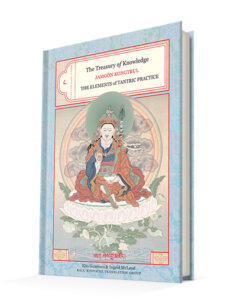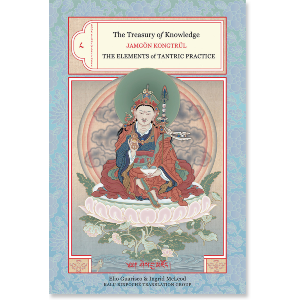
Kongtrul discusses many details of the creation-phase practice, including suitable places, times and durations of practice, and the materials required for practice. For general purposes, most tantras advise staying “in a place that is secluded and pleasant” to accomplish general purposes. They also describe the types of places to be used for specific purposes. Kongtrul recommends that, above all, the place one chooses be a region in consonance with one’s own disposition. As for the times for practice, Kongtrul points out that most beginners will more easily achieve clarity in visualization by cultivating the practice at night. Once such clarity has been stabilized, one can meditate at any time. While in retreat, the practitioner must never be without certain essentials, such as qualified assistants, ritual articles, nourishing food and drink and adequate clothing. More than anything, the practitioner needs fortitude, which Kongtrul defines as “unrelenting perseverance that, despite adverse circumstances and even at the risk of one’s life, is never relaxed until the intended goal has been achieved.”
Kongtrul then describes the actual practice of the creation phase. He outlines the steps needed to prepare the practitioner for the main practice: the offering of sacrificial food to dispel interferences; the visualization of a circle of protection; generating the mind of awakening to develop positive potential; and meditating on emptiness to cultivate pristine awareness.
The main practice begins with the creation of the celestial palace of residence. According to most tantras, the base for the creation of the palace is the visualization of a tetrahedral dharmodaya and the tiers of the four elements. The celestial palace itself is generated from a syllable, an insignia, or the melting of a deity’s form. Some tantras describe charnel grounds along with particular trees, guardians, and so on, to be imagined outside the celestial palace.
The next step is the creation of the entire array of the resident deities. Three main procedures are followed: creation by means of the five actual awakenings; creation in four vajra steps; and creation by means of three vajra rites.
Creation by means of the five awakenings entails five steps that represent the five pristine awarenesses. The first is the generation of a moon, referred to as “awakening by means of mirror-like pristine awareness”; the second, of a sun, “awakening by the pristine awareness of sameness”; the third, of the seed-syllable and insignia, “awakening by the discerning pristine awareness”; the fourth, the merging of all these elements, “awakening by the pristine awareness of accomplishment”; and fifth, the full manifestation of the deity’s body, “awakening by the pristine awareness of the ultimate dimension of phenomena.”
Creation in four vajra steps entails meditation on emptiness; generating a moon, sun, and seed-syllable from which light emanates and then converges; the full manifestation of the deity resulting from the convergence of the light and transformation of the seed-syllable; and visualization of three syllables at the deity’s three places.
Creation by means of three vajra rites involves imagining the deity’s seed-syllable; the seed-syllable’s transformation into the deity’s insignia; and the insignia’s transformation into the full manifestation of the deity’s body.
The majority of tantras include the step known as the placement of the three beings, the pledge-being, the pristine-awareness-being, and the contemplation-being. The pledge-being means the particular deity generated through the ritual, that is, the deity who is the object of meditation. At the heart of the pledge deity is the pristine-awareness-being, imagined as a deity identical to the pledge deity; as a deity differing from the pledge deity in colour, appearance, or number of faces and arms; or as an insignia arisen from a seed-syllable. At the heart of the pristine-awareness-being is the contemplation-being, visualized as the seed-syllable or insignia. In some tantras, the placement of the three beings is enacted for all the deities; in others, for only the principal deities.
Kongtrul also reveals a number of steps that complete the creation-phase meditation. The step of absorbing the pristine-awareness mandala into oneself dispels the notion that oneself and the pristine-awareness deities are separate, and reinforces the “pride” of being indivisible from them. Conferral of initiation cleanses oneself of impurities and establishes the potency required to accomplish the ultimate goal of the tantra. The different types of sealing, such as the deity being sealed by the lord of a buddha family, ensure that meditation is carried out without misidentification. The tasting of nectar, offering, and praise, for which there are many variations from one tantra to the next, bring about the understanding that all objects of experience, the sensory pleasures, and so forth, are the pure expressions of bliss and emptiness.
Kongtrul explains that all the varieties of the creation phase incorporate the four key elements of form, imagination, result, and transformative power. “Form” means meditating on forms that represent the aspects of awakening and generating clear images of these forms, thereby stopping impure appearances. “Imagination” means using the force of creative imagination to convert the visualized forms of awakening into reality. “Result” means meditating on the result, that is, the very goal to be attained, and thereby achieving that goal. “Transformative power” means turning the ordinary body and mind into pristine awareness by relying on the transformative powers of awakened beings. Among these, Kongtrul points out, the most important element for realization of the path is the transformative power of the vajra master combined with one’s own devotion to that master.
In addition to those four key elements, creation-phase practice requires the development of clarity in visualization. To that end, one repeatedly brings forth clear images in both the coarse and subtle aspects of visualization. Moreover, one practices the meditation while firmly identifying with the deity. As one trains in the phase of creation, one must understand that the entire mandala is like an illusion, devoid of inherent nature, ultimately emptiness. Finally, one must manifest the pristine awareness in which the appearance of the deity (along with the certainty of being the deity) arises unceasingly as the essence of bliss and emptiness.
The practitioner who grows tired from the effort of visualizing the deity is advised to introduce a new element: the recollection of the pure nature of the deity. This means to recall the symbolic meanings of the different elements in the visualization, which represent the great qualities of the buddhas. For example, in meditation on Avalokiteshvara, one would recall that his single face symbolizes the single taste of all phenomena, his four arms symbolize the four boundless qualities of love, compassion, joy, and equanimity, and so on. Bringing to mind the purity of these attributes counteracts the notion that the attributes of the path and those of the result are different.
The phase of creation ends with the dissolution of the visualization. The mandala residence and resident deities dissolve into oneself. Then, one dissolves gradually into luminous clarity, once again to emerge as the deity.


